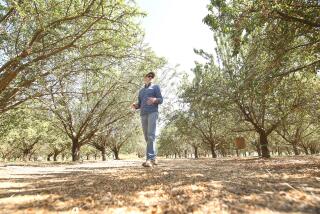Gypsy Moth Infestation Discovered in Encino
- Share via
State agriculture officials said Tuesday that eggs of the gypsy moth, a dreaded leaf-eating insect that has laid waste to an estimated 2.5 million acres of U. S. forest so far this year, were found last month in a doll house brought to Encino two years ago by a family relocating from Massachusetts.
As a result, the officials said, California is experiencing its first gypsy moth infestation in two years, although the nine moths and three egg nests found in the hills of Encino last month constitute a very small infestation that probably can be controlled relatively easily, said Gera Curry, spokeswoman for the state Department of Food and Agriculture.
Nonetheless, Curry said the department will hold a public meeting next week in Encino to seek the opinion of residents and a panel of experts before deciding how to eradicate the pests. The insect multiplies rapidly and eats the leaves of trees, which then often die slow deaths.
“They are voracious,” Curry said of the gypsy moth. Each insect, when it reaches the caterpillar stage, eats an average of seven leaves a day.
Severe Damage in Northeast
“It would just defoliate all our greenery, which makes the city bearable,” said Bob Atkins, a senior inspector with the office of the Los Angeles County Agricultural Commissioner. Moth infestations in the Northeast have caused extensive damage in the past 10 years.
California has about 150,000 gypsy moth traps across the state. The traps, often attached to tree trunks or telephone poles, lure male gypsy moths with a sex hormone.
Last month, after state inspectors found the moths, they searched the Encino area near Royal Oak Road and Skytop Street and found the egg nests. Curry said the nests, which contain 500 to 1,000 eggs each, are fuzzy, brownish in color and about the size of a half dollar. Those collected in Encino were sent to Sacramento for analysis.
The state also has 16 “border stops” along major highway entrances into California. Inspectors there search beneath cars they suspect to have come from infested areas in the Northeast, Curry said, noting that 248 potential infestations were headed off by vigilant inspectors last year.
The egg nests often are found in car wheel wells or outdoor furniture or recreational equipment, Curry said. Atkins said anyone who finds a nest should notify county agriculture officials before destroying it.
In Encino, the moths and egg nests found last month were close to each other, indicating that the infestation has not spread far, Curry said.
At the public meeting, to be held from 3 to 5 p.m. next Wednesday at the Encino Community Center, several entomologists and state agriculture officials will discuss methods of eradication and how extensive an area should be treated.
Curry said methods suggested or used in the past include biological pesticides, such as one that induces caterpillar starvation, chemical pesticides and mass trapping. Treatment would not take place until spring, when the eggs from any undiscovered nests hatch, she said.
One difficulty in controlling gypsy moth populations is that the insect has few natural enemies in the United States, according to Atkins. For several years, researchers have examined the possibility of importing parasites or other predators to attack them, he said.
The gypsy moth was introduced to the United States from Europe in 1869 by a careless naturalist trying to breed the insect with silkworms to produce a sturdier thread. As the story goes, Curry said, a sharp gust of wind blew the naturalist’s cage open and the caterpillars escaped.
The last infestations in California were in Alameda and Santa Cruz counties in 1984, Curry said. Gypsy moths were first recognized as a problem in California in 1980, when the state began a five-year, $8-million eradication program.
State officials would not identify the transplanted New Englanders who they said brought the moth eggs to California inadvertently and innocently.
“Let’s not vilify them,” Curry said. “Please, let’s not.”
More to Read
Sign up for Essential California
The most important California stories and recommendations in your inbox every morning.
You may occasionally receive promotional content from the Los Angeles Times.










